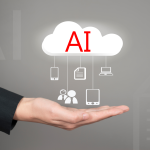AI CoE: The Brain Behind Transformation
We’re no longer in an age where AI is a side project or a speculative subject. AI has become an essential component of modern business strategy, shaping everything from customer engagement and product development to internal workflows and decision-making. But as organizations race to integrate AI, many are realizing that sprinkling AI into the mix isn’t enough. What they need is structure, governance, and a strategic brain to guide the journey.
That’s where the AI Center of Excellence (CoE) comes in; A dedicated nerve center designed to oversee, scale, and sustain AI adoption across the organization. This blog explores what an AI CoE is, why it matters, what it does, and how companies can build one that truly delivers value.
What Is an AI Center of Excellence?
An AI Center of Excellence is not just another team of data scientists tucked away in a corner. It’s a strategic, cross-functional hub that drives the responsible and effective use of AI technologies across the entire enterprise. The CoE isn’t focused solely on execution; it sets the vision, creates standards, shares knowledge, and ensures consistency.
Think of it as the architect of AI transformation, aligning AI initiatives with business goals, nurturing talent, choosing the right technologies, and shaping the governance needed to manage risk and scale innovation.
Why Organizations Need an AI CoE
Many companies jump into AI by experimenting with pilots and proof-of-concepts (POCs) within individual departments. These pieces of efforts can be useful learning experiences, but they often hit a wall when it’s time to scale or replicate. Inconsistent data practices, redundant tool purchases, ethical blind spots, and talent shortages are common obstacles.
An AI CoE solves these problems by:
- Establishing standards for AI development, testing, and deployment.
- Fostering collaboration across departments to avoid duplication and different approaches.
- Driving governance to ensure ethical, legal, and fair AI use.
- Accelerating innovation by sharing reusable assets like models, code, datasets, and lessons learned.
- Building internal capabilities through training and mentoring programs.
In short, the CoE creates a center of gravity for all things AI, making sure efforts are coordinated, scalable, and aligned with business impact.
Key Functions of an AI CoE
Although AI CoEs vary by organization, most mature models perform the following core functions:
1. Strategy and Vision Alignment
The CoE defines the organization’s overarching AI strategy and ensures that each AI initiative is connected to measurable business outcomes. It helps prioritize use cases based on ROI potential, feasibility, and ethical considerations.
2. AI Governance and Ethics
It’s easy to get lost in the excitement of what AI can do, but the CoE ensures you also ask what AI should do. This includes:
- Developing ethical guidelines,
- Ensuring transparency in algorithmic decisions,
- Managing bias and fairness,
- Overseeing compliance with regulations like GDPR, HIPAA, or local labor laws.
3. Technology and Tools Selection
The CoE evaluates and standardizes tools, platforms, and frameworks—ranging from cloud services and data pipelines to machine learning operations (MLOps) platforms. This prevents the chaos of tech sprawl and makes support easier for IT.
4. Talent Development and Culture Building
It’s not just about hiring more data scientists. The CoE supports a broader AI fluency across departments—through training, workshops, and career paths that help employees become AI-aware and AI-literate, regardless of role.
5. Innovation Incubation and Experimentation
The CoE often acts as a sandbox for AI experimentation, allowing teams to test ideas in a controlled environment before scaling them. These early wins, when successful, fuel momentum and executive buy-in.
6. Knowledge Management and Reuse
Every AI project generates insights—technical, organizational, and operational. The CoE documents these learnings and creates reusable assets like data labeling guides, model templates, and best practices libraries.
The Organizational Setup: Who Runs the CoE?
A successful AI CoE is cross-functional by design. It typically includes:
- AI/ML Engineers and Data Scientists: To lead model development.
- Data Engineers: To ensure data pipelines are clean, secure, and scalable.
- Product Owners: To tie AI capabilities to business use cases.
- Legal and Compliance Experts: To embed responsible AI practices.
- HR and L&D Leaders: To drive upskilling and talent alignment.
- Change Management Professionals: To manage adoption, fear, and resistance.
Leadership is usually assigned to a Head of AI CoE or Chief AI Officer, who reports to the CTO, CIO, or directly to the CEO depending on how central AI is to the organization’s growth strategy.
What Makes an AI CoE Succeed?
Not every CoE becomes a powerhouse. Some fall into the trap of becoming bureaucratic bottlenecks. Others lose credibility by failing to demonstrate business value. Here are the success factors:
- Executive Sponsorship: Senior leadership must champion the CoE, provide funding, and advocate for its authority.
- Clear Mandate: The CoE should have defined goals, KPIs, and scope. Is it focused on innovation? Governance? Delivery support? Be explicit.
- Business Partnership: It must work with business units, not above them. Co-creation is key to adoption.
- Agility Over Perfection: AI is fast-moving. The CoE must be flexible, continuously learning and iterating rather than chasing an impossible ideal.
- Communication and Storytelling: The CoE should actively share success stories, metrics, and lessons to keep stakeholders engaged and informed.
Real-World Example: A Manufacturing Company’s AI CoE in Action
A global manufacturing company launched its AI CoE to address inefficiencies in predictive maintenance, supply chain forecasting, and production planning. Instead of jumping into one-off tools, the CoE mapped out a 2-year AI strategy, prioritized high-impact use cases, and designed scalable models.
Within a year:
- Predictive maintenance reduced downtime by 23%.
- AI-driven demand forecasting improved inventory accuracy by 17%.
- Training programs boosted internal AI fluency across operations teams.
The CoE didn’t just ship algorithms—it changed the organization’s relationship with AI.
Final Thoughts: CoE Is the Mindset, Not Just the Model
AI is not plug-and-play. It’s an ongoing journey of discovery, transformation, and adaptation. And while every company’s AI roadmap looks different, a Center of Excellence provides the navigational system to guide that journey safely and effectively.
The CoE is not about centralizing control; it’s about amplifying capability. It turns isolated pilots into enterprise-wide transformation. It connects technology with trust, data with decisions, and innovation with impact.
For organizations serious about embedding AI into their DNA—not just as a tool but as a competitive advantage—the AI Center of Excellence is the smartest place to start.


